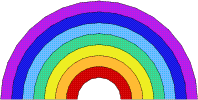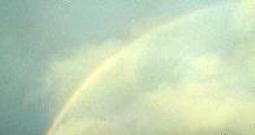
Rainbows


|
Rainbows |
 |
I've got a wooden rainbow sitting on a shelf in my living room.
A wooden rainbow made of seven separate arcs of colour, red,
orange, yellow, green, blue, indigo.
violet. The accompanying leaflet showed other objects that could
be made with the seven pieces, but nothing looks as satisfactory as
the rainbow.
Sure, it's not like a real rainbow. Its arch is tighter, and thicker, and the wood has a solidity that fails to represent the translucence, light and beauty of the real thing.
But it is a bright and cheerful object, and I like to see it there amongst the other ornaments. And if the grandchildren want to play with it that's OK too, as it's not too fragile or too precious to be played with.

Well, it was my turn to give the 'children's teaching' in church, and I'd nearly forgotten until the day before. I looked through all my old children's stories, but I couldn't find anything that wasn't hopelessly dated. The language wasn't inclusive, the rabbit children were always boys, and one of the old favourites, about a little boy who went to the woods and brought home a shy but friendly lil' ol' bear to play with (how I used to admire that loving mother who played along with her son's imaginings, AND who had freshly baked cookies to share . . .) alas, the little boy took his gun with him into the wood and although the pictures clearly showed that it was just two pieces of wood nailed together, still, that story was out.
What to do? My rainbow! And I'll link it up with a good old story from the Bible, the story of Noah and the ark. But, Oh dear! How ever was the story of Noah's ark considered a children's story? A story about the wickedness of people on earth, about God's violence against humankind, and about the devastation of the earth, and on the other hand, a story about one good man and his family, God's saving of one family, and finally, about a rainbow . . .
There were other difficulties with the story: did Noah take two of every animal, or seven? Did the rain last 40 days or 150? five months or ten? And why, oh why, did Noah save the animals from the flood only to sacrifice some to God in thanksgiving at the end? And it is, it seems (in Genesis 6) yet another story about a father and his sons!
I knew the variants in the details could be explained by the different strands of the story being blended into one narrative. I found in the telling it was easy to avoid details of numbers, but I could have plumped for two animals, 40 days of rain.
I have to confess that the story I told the children was considerably
modified. More of the decisions were made by Noah than by God
telling him what to do.
|
Noah was a good man and trusted in God. It rained and it rained
and it rained, and Noah decided it would be a wise thing to build a
boat to keep himself and his family safe. He and his sons built
a good and strong boat and inside it they put all different sorts of animals
to keep them safe also (I let the children suggest some animals)
and lots of food to eat while they were in the boat. And Noah
and Mrs Noah (this seemed to be a surprise to the adults, but
yes, in Genesis chapter 7 Noah and his three sons all have
wives, although the wives are not named) and Shem and Mrs
Shem, and Ham and Mrs Ham, and Japheth and Mrs Japheth all got
into the ark. And it rained and it rained and it rained
(we look at the picture of the flood in the book I have brought, and
there is lots of very brown and dirty water and a very little boat being
tossed on the waves) but they were all safe inside the ark.
And when it finally stops raining, they thank God for keeping them safe (in Benjamin Britten's 'Noye's fludde' the company all sing a hymn of thanks to God) and all the animals and Noah and Mrs Noah, and Shem and Mrs Shem, and Ham and Mrs Ham, and Japheth and Mrs Japheth (and the animals) leave the ark. And a beautiful rainbow appears in the sky (the children point triumphantly to the rainbow in the picture book as if they too need the confirmation, the certainty of the image). It is a sign from God that the rain is over and that God loves them, and will always look after them. |

But some further thoughts about this story -- A rainbow is a thing of light contrasting with the dark of the storm which preceded it. The requirements for a rainbow to appear are to have both rain and sunlight. So, (contrary to the text) it can't have completely stopped raining when the rainbow appeared! However since there hadn't been any sunshine for 40 days (or perhaps ten months?) previously, the emphasis is on the promise of sunshine and the end of the rain.
And a rainbow is a beautiful and a wondrous thing. We know that the colours of the spectrum are produced by the light being reflected in the raindrops, but this scientific explanation fails (for me) to explain the beauty of the colours or the symmetry of a perfect bow. And when I read more about rainbows I also learned that you cannot see a rainbow at midday 'when the sun is at the zenith'. And so, I wondered, did Noah's rainbow appear at the end of the day, signifying rest and sleep and an end of anxieties? or was it on a new and fresh morning that Noah & Co saw the rainbow, and were able to set out on their new day and life?
I was interested that the one or two commentaries I consulted on this story said very little about the rainbow. It was accepted as God's sign of promise and covenant without a lot of explanation.
I like to think of these early story writers who were so sensitive to the natural world, who appreciated the beauty of rainbows, and interpreted that beauty as God's. I suspect also that the rainbow was seen as a link between heaven and earth (in their understanding of the universe), of God's reaching out (down) from heaven to the earth in love. And in seeing it as God's sign of covenant they were seeing a renewable sign, that would keep on reminding them over the years, the centuries, the ages, of God's promise and love.
Rainbows are light, and beauty and promise. Rainbows make me happy.
Thank you, God, for rainbows!
Joan Robertson